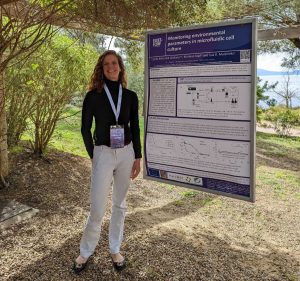ALTERNATIVE results presented at MicroPhysio conference in Cargèse
ALTERNATIVE consortium partner Elvesys presented selected project results at the first edition of the MicroPhysio conference on “Micro-physiological models: From organoids to organs-on-chip”, which took place at the CNRS center in Cargèse, Corsica (France) from 11th to 15th April 2022. The ALTERNATIVE project was represented by Camila Betterelli Giuliano, PhD candidate at the Innovation Unit of Elvesys. In a poster session, she explained project results on monitoring environmental parameters in microfluidic cell culture.

Camila Betterelli Guliano from Elvesys presenting results on monitoring environmental parameters in microfluidic cell culture
Monitoring environmental parameters in microfluidic cell culture
CO2 incubators are the silent enablers of most of the advancements of cell biology in modern biology research and health. They keep cells under constant physiological temperature (37oC), humidity and CO2 levels to buffer the pH of the media during cell growth. Organ-on-chip (OoC) has gained relevance in recent years for adding complexity to traditional cell culture, better replicating physiological conditions of mechanical stimulus and cell-to-cell interactions.
However, OOC still depends substantially on the traditional infrastructure of cell culture, such as the CO2 incubator for maintaining appropriate levels of CO2 and temperature during long-term culturing on-chip. In particular, part of the culture setup often remains inside the incubator, mainly the chip, while part is outside, including media reservoirs and tubing. Due to the large surface area, volume ratio and varying gas permeability of the components, this can lead to variations in temperature and gas concentration between the culture surface and the rest of the fluidic circuit. Also, CO2 incubators are usually large pieces of equipment that are not necessarily located near the data-gathering instruments, usually microscopes. This can create difficulty when the chip needs to be moved from the incubator to the microscope stage at defined time points to gather data. Besides limiting continuous monitoring, the effects of the changing conditions over the cells are not well-understood. To close this knowledge gap, this work aims at understanding and characterizing the parameters of pH, CO2 and O2 in microfluidic cell culture.
Preliminary studies investigated the effect of chips and tubing with different gas permeability on the pH of medium and cell survival rates in multi-day microfluidic cell culture, replicating different OoC setups. Next steps include the characterization of the effect of O2 in a similar manner. A better understanding of the effect of these parameters on microfluidic cell culture will allow researchers to better isolate variables and have more flexibility in modulating the setup to finetune their experiments.
Further information
MicroPhysio conference website – https://microphysio20.sciencesconf.org





